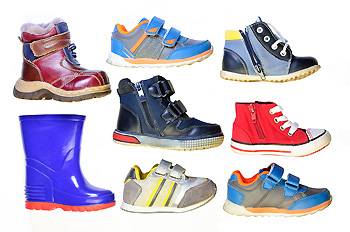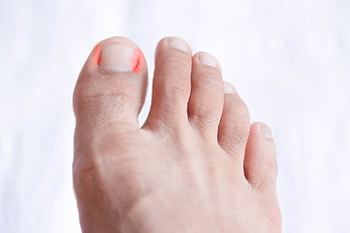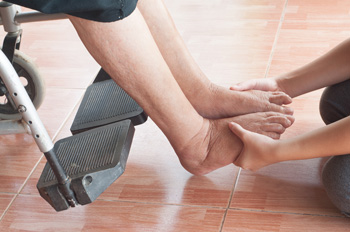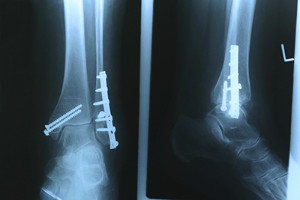Items filtered by date: June 2021
Swollen Ankles in Seniors
If you’re an older adult, you may have noticed swelling around your ankles. This is a common condition among seniors and is caused by fluid accumulating in the soft tissue surrounding the ankles or in the ankle joint. The swelling may be due to prolonged standing, eating a diet high in salt, sitting for extended periods of time, sustaining an ankle injury, or taking certain medications. It could also be caused by a variety of underlying medical conditions. Although ankle swelling is common, it should not be dismissed or ignored. If you have swollen ankles, it is suggested that you visit a podiatrist, who can help determine the cause of the swelling and offer the appropriate treatments.
Proper foot care is something many older adults forget to consider. If you have any concerns about your feet and ankles, contact Dr. Steven Sheridan from Ankle & Foot Specialty Clinics. Our doctor can provide the care you need to keep you pain-free and on your feet.
The Elderly and Their Feet
As we age we start to notice many changes in our body, but the elder population may not notice them right away. Medical conditions may prevent the elderly to take notice of their foot health right away. Poor vision is a lead contributor to not taking action for the elderly.
Common Conditions
- Neuropathy – can reduce feeling in the feet and can hide many life-threatening medical conditions.
- Reduced flexibility – prevents the ability of proper toenail trimming, and foot cleaning. If left untreated, it may lead to further medical issues.
- Foot sores – amongst the older population can be serious before they are discovered. Some of the problematic conditions they may face are:
- Gouging toenails affecting nearby toe
- Shoes that don’t fit properly
- Pressure sores
- Loss of circulation in legs & feet
- Edema & swelling of feet and ankles
Susceptible Infections
Diabetes and poor circulation can cause general loss of sensitivity over the years, turning a simple cut into a serious issue.
If you have any questions please feel free to contact our office located in Sandusky, MI . We offer the newest diagnostic and treatment technologies for all your foot and ankle needs.
What to Look for in Your Child’s Shoes
 In the first 5 years of a child’s life, their feet grow very fast. Because it is also important that the bones in the feet grow straight, proper footwear is very important. As a baby, the bones in the toes are very soft, and shoes or socks that are too tight can prevent those bones from growing properly. In fact, children generally don’t need shoes until they begin walking on their own. Shoes that fasten with velcro are also important because they can help hold the heel in place and keep the foot from slipping. If you have other questions or concerns about what shoes your child should be wearing, a podiatrist will be able to help make further recommendations.
In the first 5 years of a child’s life, their feet grow very fast. Because it is also important that the bones in the feet grow straight, proper footwear is very important. As a baby, the bones in the toes are very soft, and shoes or socks that are too tight can prevent those bones from growing properly. In fact, children generally don’t need shoes until they begin walking on their own. Shoes that fasten with velcro are also important because they can help hold the heel in place and keep the foot from slipping. If you have other questions or concerns about what shoes your child should be wearing, a podiatrist will be able to help make further recommendations.
Making sure that your children maintain good foot health is very important as they grow. If you have any questions, contact Dr. Steven Sheridan of Ankle & Foot Specialty Clinics. Our doctor can provide the care you need to keep you pain-free and on your feet.
Keeping Children's Feet Healthy
Having healthy feet during childhood can help prevent medical problems later in life, namely in the back and legs. As children grow, their feet require different types of care. Here are some things to consider...
Although babies do not walk yet, it is still very important to take care of their feet.
Avoid putting tight shoes or socks on his or her feet.
Allow the baby to stretch and kick his or her feet to feel comfortable.
As a toddler, kids are now on the move and begin to develop differently. At this age, toddlers are getting a feel for walking, so don’t be alarmed if your toddler is unsteady or ‘walks funny’.
As your child gets older, it is important to teach them how to take care of their feet.
Show them proper hygiene to prevent infections such as fungus.
Be watchful for any pain or injury.
Have all injuries checked by a doctor as soon as possible.
Comfortable, protective shoes should always be worn, especially at play.
If you have any questions please feel free to contact our office located in Sandusky, MI . We offer the newest diagnostic and treatment technologies for all your foot and ankle needs.
Typical Ankle Injuries to Be Aware Of
The ankle is comprised of muscles, bones, tendons, ligaments, and cartilage—all of which can become injured in different ways with varying degrees of ankle pain. Superficial cuts, bruises, and abrasions usually produce mild pain, whereas deeper lacerations can be more painful, penetrating the skin and possibly requiring stitches. Ankle strains, or pulled muscles, occur when muscles have been overstretched or torn, and can cause moderate pain. Ankle sprains are more serious and often more painful as ligaments are damaged and splinting or casting may be necessary to heal properly. When a bone becomes dislocated, it pops out of the joint, causing severe pain, and requires professional attention. Similarly, when a bone in the ankle is broken (fractured), it can be severely painful and swollen, also requiring medical attention. With an Achilles tendon rupture, there may be a popping sound at the moment of injury and pain may range from mild to moderate. If you have injured your ankle, it is suggested that you contact a podiatrist to examine and assess the injury and create an appropriate treatment plan.
Ankle pain can have many different causes and the pain may potentially be serious. If you have ankle pain, consult with Dr. Steven Sheridan from Ankle & Foot Specialty Clinics. Our doctor will assess your condition and provide you with quality foot and ankle treatment.
Ankle pain is any condition that causes pain in the ankle. Due to the fact that the ankle consists of tendons, muscles, bones, and ligaments, ankle pain can come from a number of different conditions.
Causes
The most common causes of ankle pain include:
- Types of arthritis (rheumatoid, osteoarthritis, and gout)
- Ankle sprains
- Broken ankles
- Achilles tendinitis
- Achilles tendon rupture
- Stress fractures
- Tarsal tunnel syndrome
- Plantar fasciitis
Symptoms
Symptoms of ankle injury vary based upon the condition. Pain may include general pain and discomfort, swelling, aching, redness, bruising, burning or stabbing sensations, and/or loss of sensation.
Diagnosis
Due to the wide variety of potential causes of ankle pain, podiatrists will utilize a number of different methods to properly diagnose ankle pain. This can include asking for personal and family medical histories and of any recent injuries. Further diagnosis may include sensation tests, a physical examination, and potentially x-rays or other imaging tests.
Treatment
Just as the range of causes varies widely, so do treatments. Some more common treatments are rest, ice packs, keeping pressure off the foot, orthotics and braces, medication for inflammation and pain, and surgery.
If you have any questions, please feel free to contact our office located in Sandusky, MI . We offer the newest diagnostic and treatment technologies for all your foot care needs.
Are You Suffering From Ingrown Toenails?
How Ingrown Toenails Occur
 An ingrown toenail occurs when the toenail curves and grows down into the skin on the sides of the nail. As the toenail digs into the flesh and the flesh grows around it, pain, inflammation, redness, swelling or even an infection can follow. Common factors that lead to ingrown toenails include genetics (such as poor posture, gait, or a deformity), improperly cutting the toenails, and wearing tight shoes. Ingrown toenails are not usually serious. However, they can become very painful and infected if left untreated. If you have diabetes or a compromised immune system, your nail is in persistent pain, or your nail is showing signs of being infected, you should consult with a podiatrist for a proper treatment option.
An ingrown toenail occurs when the toenail curves and grows down into the skin on the sides of the nail. As the toenail digs into the flesh and the flesh grows around it, pain, inflammation, redness, swelling or even an infection can follow. Common factors that lead to ingrown toenails include genetics (such as poor posture, gait, or a deformity), improperly cutting the toenails, and wearing tight shoes. Ingrown toenails are not usually serious. However, they can become very painful and infected if left untreated. If you have diabetes or a compromised immune system, your nail is in persistent pain, or your nail is showing signs of being infected, you should consult with a podiatrist for a proper treatment option.
Ingrown toenails may initially present themselves as a minor discomfort, but they may progress into an infection in the skin without proper treatment. For more information about ingrown toenails, contact Dr. Steven Sheridan of Ankle & Foot Specialty Clinics. Our doctor can provide the care you need to keep you pain-free and on your feet.
Ingrown Toenails
Ingrown toenails are caused when the corner or side of a toenail grows into the soft flesh surrounding it. They often result in redness, swelling, pain, and in some cases, infection. This condition typically affects the big toe and may recur if it is not treated properly.
Causes
- Improper toenail trimming
- Genetics
- Improper shoe fitting
- Injury from pedicures or nail picking
- Abnormal gait
- Poor hygiene
You are more likely to develop an ingrown toenail if you are obese, have diabetes, arthritis, or have any fungal infection in your nails. Additionally, people who have foot or toe deformities are at a higher risk of developing an ingrown toenail.
Symptoms
Some symptoms of ingrown toenails are redness, swelling, and pain. In rare cases, there may be a yellowish drainage coming from the nail.
Treatment
Ignoring an ingrown toenail can have serious complications. Infections of the nail border can progress to a deeper soft-tissue infection, which can then turn into a bone infection. You should always speak with your podiatrist if you suspect you have an ingrown toenail, especially if you have diabetes or poor circulation.
If you have any questions, please feel free to contact our office located in Sandusky, MI . We offer the newest diagnostic and treatment technologies for all your foot care needs.
Is It a Corn, or a Callus?
 Corns and calluses are similar in that they are both patches of dry skin that can appear on the feet in response to friction. Corns are small lumps of hardened skin that resemble a corn kernel in appearance. They often form on the soles of the feet or in between the toes and can be yellowish in color. Calluses are larger patches of rough, thick skin that often appear on the balls or heels of the feet. While both corns and calluses can usually be treated with conservative methods such as wearing wider, more comfortable shoes, moisturizing the skin, and wearing thicker, cushioned socks, certain cases may require medical intervention. If you have diabetes, circulatory problems, notice signs of infection such as bleeding or pus discharge, or are in severe pain, please seek the care of a podiatrist.
Corns and calluses are similar in that they are both patches of dry skin that can appear on the feet in response to friction. Corns are small lumps of hardened skin that resemble a corn kernel in appearance. They often form on the soles of the feet or in between the toes and can be yellowish in color. Calluses are larger patches of rough, thick skin that often appear on the balls or heels of the feet. While both corns and calluses can usually be treated with conservative methods such as wearing wider, more comfortable shoes, moisturizing the skin, and wearing thicker, cushioned socks, certain cases may require medical intervention. If you have diabetes, circulatory problems, notice signs of infection such as bleeding or pus discharge, or are in severe pain, please seek the care of a podiatrist.
If you have any concerns regarding your feet and ankles, contact Dr. Steven Sheridan of Ankle & Foot Specialty Clinics. Our doctor will treat your foot and ankle needs.
Corns: What Are They? and How Do You Get Rid of Them?
Corns can be described as areas of the skin that have thickened to the point of becoming painful or irritating. They are often layers and layers of the skin that have become dry and rough, and are normally smaller than calluses.
Ways to Prevent Corns
There are many ways to get rid of painful corns such as wearing:
- Well-fitting socks
- Comfortable shoes that are not tight around your foot
- Shoes that offer support
Treating Corns
Treatment of corns involves removing the dead skin that has built up in the specific area of the foot. Consult with Our doctor to determine the best treatment option for your case of corns.
If you have any questions please feel free to contact our office located in Sandusky, MI . We offer the newest diagnostic and treatment technologies for all your foot and ankle needs.



